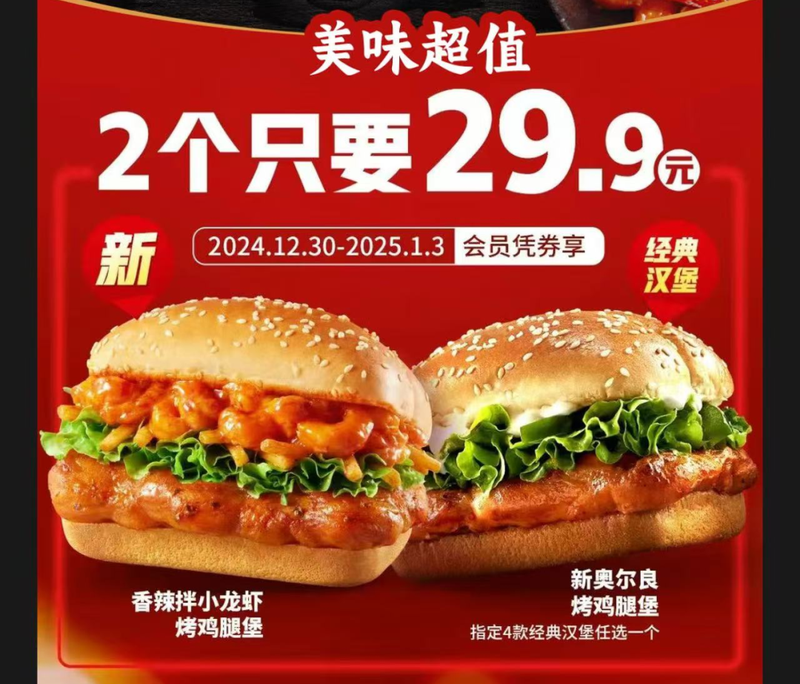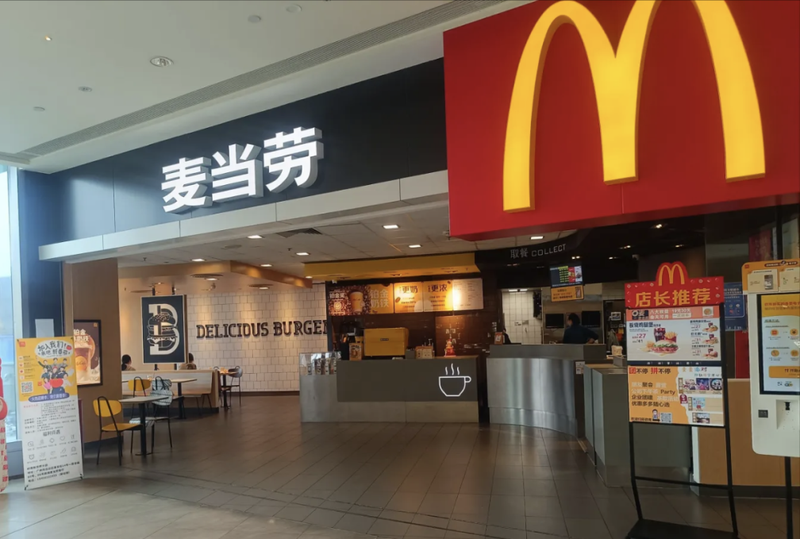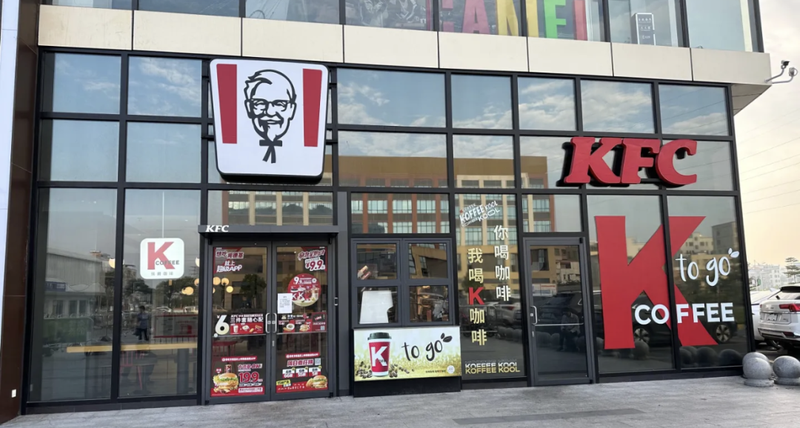Make money from Lucky to open a smaller store.
There are running out of counties left for KFC to open stores
Wen | Source Sight Anran
From Salia to Luckin Coffee, in 2025, KFC will continue to venture into the comfort zone of its peers.
Recently, KFC parent company Yum China disclosed its latest operating situation.
In the fourth quarter of 2024, Yum China’s total revenue achieved US$2.6 billion, a year-on-year increase of 4%(excluding the impact of foreign currency conversion). During the period, the company’s same-store transaction volume increased for the eighth consecutive quarter. Among them, KFC increased by 3% year-on-year; Pizza Hut increased by 9% year-on-year.
For the full year of 2024, Yum China’s total revenue reached US$11.3 billion, a year-on-year increase of 5%(excluding the impact of foreign currency conversion); core operating profit was US$1.2 billion, a year-on-year increase of 12%.
However, as same-store transaction volume rose and total revenue hit a record high, Yum China’s same-store sales growth has gone downhill. In 2024, Yum China same-store sales will fall by 3% year-on-year. During the period, KFC same-store sales fell 2%, and Pizza Hut fell 5%.
As the sinking and stormy stores are encrypted, the original customer base is diverted, and higher discounts and lower average fares are adjusted to adapt to sinking routes, KFC’s same-store sales have declined and the restaurant’s profit margin has been squeezed.
Excluding items that affect restaurate-level comparability, in 2024, KFC restaurant profit margins will drop by 20 basis points to 16.9%, and annual operating profit will drop by 11% year-on-year to US$1.2 billion.
As the new store Sariya strives to break even and even profit growth, the new business K-Coffee is a dark horse, with sales growth of 30% or more for two consecutive years.
After brands such as Ruixing Coffee have created a mentality for low-cost coffee consumption, and cannot withstand the trend of price wars and subtle price increases, K-Cofee relies on the advantages of large groups to stabilize the attractive price band of 9.9 yuan, or provides income-generating feedback for KFC and others.
However, compared with Mai Coffee and others, K-Cofee still does not have an advantage in terms of price, number of SKUs, and number of stores, and there is still more room for development.
Saliyahua
From the perspective of increasing income and scale expansion, Yum China will achieve outstanding results in 2024.
Total revenue in 2024 will be US$11.3 billion, a year-on-year increase of 5%, setting a new high since the spin-off. Among them, KFC’s revenue was approximately US$8.51 billion, and Pizza Hut’s revenue was US$2.26 billion, accounting for 75% and 20% respectively.
Store expansion accelerates. As of 2024, the total number of Yum China stores has increased by 12% year-on-year to 16395, with a net addition of 1751 stores. Among them, there are 512 franchise stores, accounting for approximately 29% of the total number of net new stores.
According to the financial report, Yum China will return US$1.5 billion to shareholders throughout 2024, and plans to return US$4.5 billion to shareholders from 2024 to 2026.
But there are hidden hidden concerns behind the gratifying data.
Under the influence of returning to parity and high cost performance as a domestic consumption trend, and adjusting the unit price of new customers in low-line urban franchise stores expanding, the operating profit margins of Yum China’s restaurants have been squeezed.
According to a survey conducted by the “2024 China Chinese Catering White Paper”, 67% of consumers believe that they are more cost-effective in terms of diet;65% of consumers say they are careful in terms of diet and hope to experience quality that will never be downgraded at a downgraded price.
In order to comply with changes in consumption trends, KFC and Pizza Hut have carefully stepped on the cost-effective product line in the past year.
KFC chose to lower the burger price first.
In April 2024, KFC launched a time-limited event for a 9.9-yuan burger coupon, which brought the price to below 10 yuan including four products including original chicken burger and spicy chicken leg burger. The application scope has also been expanded from delivery only to delivery + serving food; In June of the same year, KFC ‘s Crazy Thursday series was launched, and the price of the new juice pot wrapped meat was also reduced to 9.9 yuan.
In addition, when the new products such as Crayfish Burger and Classic Meat Burger returned, KFC also offered a promotional discount of 29.9 yuan for 2 Fort for a limited time. It is worth noting that these price adjustments are also more suitable for the consumer demand faced by KFC’s sinking expansion.

The screenshot comes from the KFC service number
Qu Cuirong, CEO of Yum China, said KFC had expanded its price range and reduced delivery fees. The average ticket price in the fourth quarter (2024) was 38 yuan, 4% lower than the same period last year.& rdquo;
Pizza Hut’s bargaining is more comprehensive and rapid.
In April 2024, Pizza Hut launched a one-person single-piece pizza burger, priced at 19.9 yuan, which is lower than the price of some regional affordable brands such as Zunbo Pizza; in June of the same year, Pizza Hut also launched a takeout pizza buy one get one free promotion, repeatedly lowering affordable ticket prices.
In December 2024, Pizza Hut offered a one-price menu. According to Hongcan.com, while launching nearly 40 new products, the menu also lowered the prices of 30 iconic products, with an overall range of 5% to 51%. Among them, the price of pizza dropped from 36.9 yuan, pasta dropped from 19.9 yuan, and the price of 7 entry-level products dropped as low as 9.9 yuan.
KFC and Pizza Hut, which have gradually become salariized, have been successful in exchanging price for quantity.
Data shows that in 2024, Pizza Hut’s sales of pizza priced at less than 50 yuan will increase by 50% year-on-year.
In the fourth quarter of 2024, Pizza Hut same-store transactions increased by 9% year-on-year, which is not only the eighth consecutive quarter of brand growth, but also the highest growth quarter in 2024; KFC same-store transactions increased by 3%, also achieving eight consecutive quarters of growth.
However, the company’s same-store sales and earnings have been somewhat hurt by the increase in value-for-money products to attract customer flow and wage inflation.
Data shows that in 2024, Yum’s same-store sales in China will fall by 3%. Among them, Pizza Hut fell significantly, at 5%; KFC was relatively small, down 2% year-on-year.
KFC, which is more aggressive in joining and sinking, will have operating profit falling 11% year-on-year to US$1.2 billion in 2024, and operating profit margin will fall 0.6% year-on-year; excluding items that affect comparability at the restaurant level, restaurant profit margins will drop by 20 basis points to 16.9%.
Profit tug of war
Although KFC and Pizza Hut’s small store franchises and low-line expansion models have little impact on increasing profits in the short term, they are still must-have for the current Yum China.
First, the layout of high-line cities is relatively saturated, and there is currently more room for development in low-line cities.
Although small-town model stores have been explored since 2020 and further promoted the expansion of mini stores in counties and towns in May 2024, KFC and Pizza Hut still do not have an advantage in the number of stores in low-tier cities.
Narrow Gate catering data shows that as of February 10, the proportion of stores in KFC’s first-tier and second-tier cities still accounted for 64.5%, and the proportion of stores in third-tier and lower-tier cities was approximately 35.5%. The proportion of stores in Pizza Hut’s first-tier cities still reached 70.6%, and the proportion of stores in third-tier and lower-tier cities was approximately 29.4%.
As of the end of 2024, the total number of KFC stores has reached 11648, and the total number of Pizza Hut stores has reached 3724, which is still growing. However, narrow door catering data shows that as of February 10, there were only 1708 KFC township stores and only 263 Pizza Hut township stores. There is still great room for development.
Second, consumer demand in high-tier cities has shrunk. From the perspective of consumption vitality and operating costs, low-tier cities are more attractive to high-tier cities.
Data shows that from January to November 2024, the cumulative year-on-year growth rates of retail sales of consumer goods in the four first-tier cities of Beijing, Shanghai, Shenzhen and Guangzhou were-2.8%, -4.4%, 1.5% and 0.3% respectively, which was lower than the national year-on-year growth rate. 3.5%. Jingdong platform data also shows that consumption expenditure in first-tier cities in 2024 will be significantly lower than that in other levels of cities.
At the same time, according to survey data from the China Index Research Institute, in the first half of 2024, 69.2% of commercial streets in first-tier cities had rental increases, and 57.5% of commercial streets in second-tier cities had rental increases. The high costs in business districts in first-tier and second-tier cities have brought greater operating pressure to catering companies.
Third, competitors in the same industry are also accelerating the layout of low-level franchises, and it is imperative to grab points and quantities.

McDonald’s offline stores
Therefore, Yum China will not give up the small store franchise and low-line expansion model at present, and store expansion is still taking place on a large scale.
Data shows that in 2024, Yum China will have a net new store of 1751, and it has entered more than 2200 cities and towns. In 2025, Yum China plans to add a net 1,600 – 1,800 stores, and the number of stores will reach 20,000 by 2026.
In 2024, Yum China has 512 net new franchise stores, accounting for approximately 29% of the total net new stores. The financial report shows that the company expects that in the next few years, the proportion of franchised stores in KFC’s net new stores will gradually increase to 40%-50%, and that of Pizza Hut will increase to 20%-30%.
However, in the expansion process, under the requirements of parity trends and sinking demand, the balance between product prices and costs will become a long-term tug-of-war.
It is worth noting that Salia, a high-end player in the catering industry who specializes in extreme cost performance, is already struggling.
In the first fiscal quarter of 2025, in the three months ended November 2024, Salia’s sales revenue increased by 16.4% year-on-year to 61.275 billion yen (approximately RMB 2.842 billion).
Despite the increase in total revenue, Salia, Asia’s most important market, experienced a decline in profits in first-tier cities in mainland China. During the period, its operating profits in Shanghai, Guangzhou and Beijing were 92%, 82%, and 96% respectively of the same period last year.
While the number of stores increased by about 10% during the period, Salia’s same-store sales revenue fell by about 10%. This is tantamount to telling Yum China that low prices are risky and investment needs to be cautious.
In December 2024, KFC started price adjustments in China, with an average product price increase of 2%, with specific adjustment ranges ranging from 0.5 to 2 yuan.
However, although the prices of some products have been increased, preferential packages such as Crazy Thursday OK Meals for Children will remain unchanged at their original prices.
Yum’s struggle to balance payments and increase and decrease in profits will continue in the future.
Make money from lucky people
While Yum’s burgers and pizzas are rushing to scale while controlling the quality and price ratio, its coffee business has leapt forward as a dark horse.
Data disclosed by Yum China shows that in 2024, KFC’s K-Coffee sales will be approximately 250 million cups, a year-on-year increase of 30%, exceeding the 1.9 billion cups of freshly made coffee sold by Lucky in 2023.
The number of K-Coffee stores has increased 14-fold in one year, expanding from about 50 cafes in 2023 to 700 cafes in 2024. According to Yum China’s plan, by the end of 2025, the K-Coffee cafe model will expand to 1300 stores, nearly doubling.
Source Sight learned that taking the standard medium cup as an example, the price of K-Coffee’s single item is between 12.9 and 17 yuan. Under the discount of 19 yuan/30 days, the price can be dropped to 10-15 yuan. Unscheduled promotional offers can also push prices even lower.
Relying on the group’s advantages and KFC’s global procurement system, K-Cofee can reduce the cost of coffee beans and stabilize the attractive price band of 9.9 yuan.
However, brands such as Ruixing Coffee could not hold up the price war due to rising raw material costs and other reasons, and gradually raised prices to stab consumers.
After New Year’s Day in 2025, the original price of some Lucky products will be increased by about 3 yuan, and the overall product pricing will be adjusted from about 23-32 yuan to about 25-35 yuan. At the same time, for the landmark 9.9 yuan discount, Ruixing Coffee has also restricted the number and range of coupons used.
Qu Cuirong said that there is a good synergy between KFC and K-Coffee.
K-Coffee, which meets the demand for cost-effective coffee, seems to be able to feed back KFC’s incremental sales and profits by harvesting Lucky’s target group.
However, K-Coffee’s growth also has obvious limitations.
On the one hand, the location of KFC stores side by side limits K-Coffee’s location and expansion speed.
On the other hand, due to its high degree of binding with KFC, K-Coffee’s brand growth is also restricted. Research by relevant institutions shows that about 70% of K-Coffee customers buy it incidentally for KFC consumers, and the independent brand mentality has not been fully established.
It can be said that K-Coffee became part of KFC and was limited by KFC.

KFC offline stores
In addition, in terms of price, number of SKUs, and number of stores stationed, K-Coffee still does not have an advantage compared to its old rival McCoffee.
Source Sight learned that compared with K-Coffee, the pricing range of wheat coffee is wider. Take the standard medium cup as an example. The original price is 9.5-23 yuan per cup, covering the K-Coffee price line; there are about 12 product types, which is about twice that of K-Coffee.
On February 5, McCoffee announced that it would fully upgrade its original freshly brewed coffee to freshly brewed coffee, covering approximately 7000 McDonald’s restaurants across the country. The number of K-Cofee cafes will still be 700 by 2024, and it is planned to have only about 1300 by the end of 2025.
It is not allowed to reproduce at will without authorization, and the Blue Whale reserves the right to pursue corresponding responsibilities.



